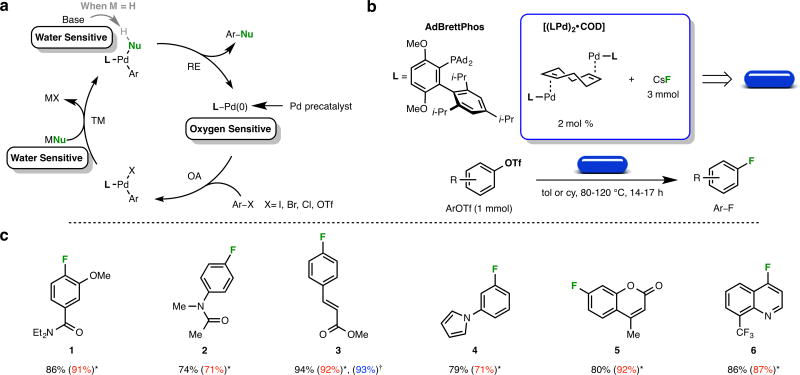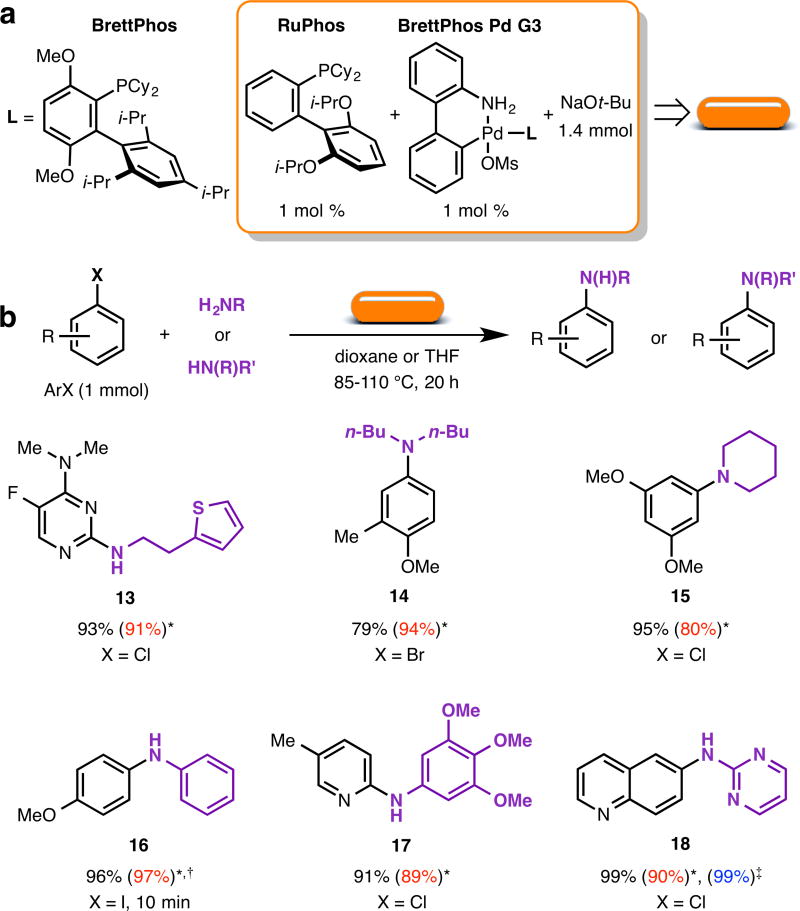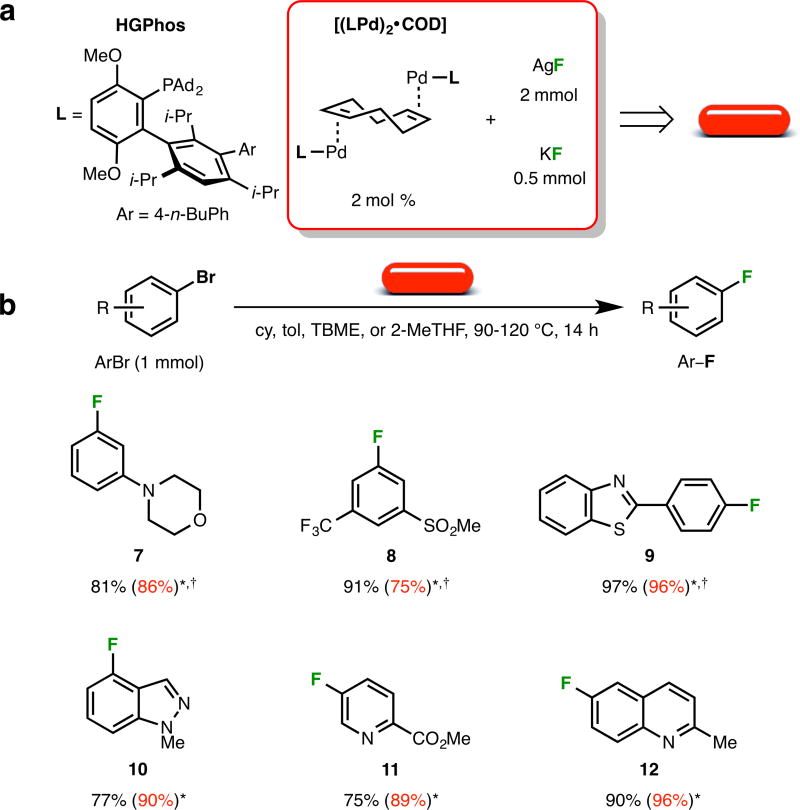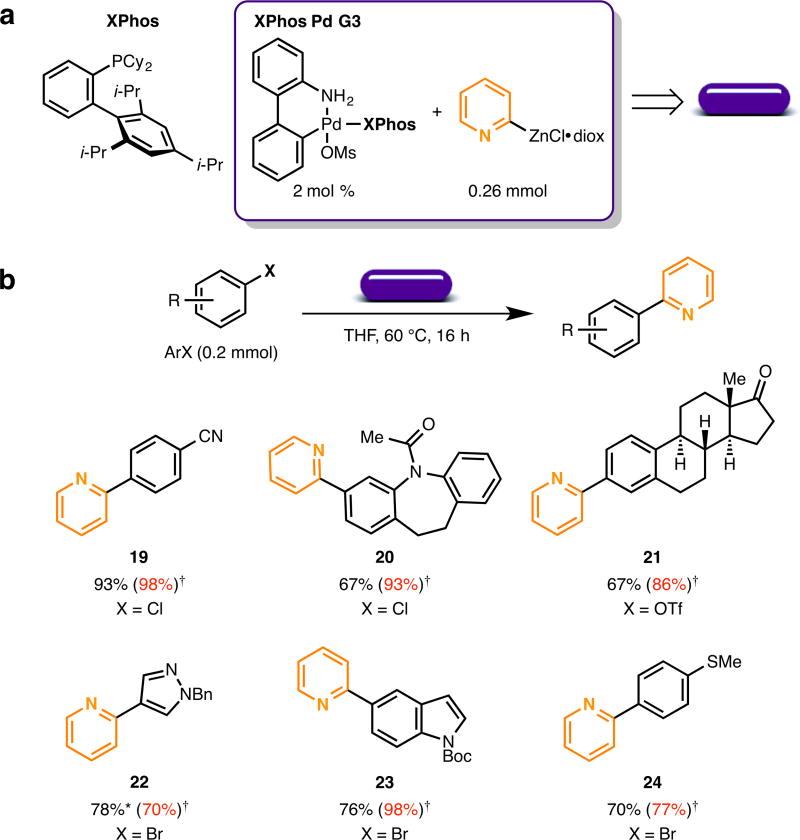Abstract
Contemporary organic chemists employ a broad range of catalytic and stoichiometric methods to construct molecules for applications in many fields, including material sciences1, pharmaceuticals2–5, agrochemicals, and sensors6. The potential utility of a synthetic method can be greatly reduced if it relies on the use of air- and/or moisture-sensitive reagents or catalysts. Furthermore, many synthetic chemistry laboratories have numerous containers of partially used reagents that have been spoiled by exposure to the ambient atmosphere. This is exceptionally wasteful from both an environmental and a cost perspective. In this manuscript, we report an encapsulation method through which air- and moisture-sensitive sensitive compounds can be rendered stable and stored on a laboratory bench top. We demonstrate this approach in three contexts, by describing single use capsules that contain all of the reagents (i.e., catalysts, ligands, and bases) necessary for palladium-catalyzed carbon–fluorine7–9, carbon–nitrogen10,11, and carbon–carbon12 bond forming reactions. The strategy described in this paper should be broadly applicable to a wide range of reagents and catalysts and should have the power to be transformative in preparative organic chemistry, particularly for inexperienced chemists. In addition, this approach will reduce the amount of tedious and time-consuming weighing procedures for the synthetic chemist performing these techniques on a large number of substrate combinations.
At the outset, we sought to develop a system to allow for the bench top storage of premeasured quantities of air- and moisture-sensitive reagents and catalysts in such a way that the contained material would be liberated into a reaction mixture upon subjection to typical reaction conditions. We initially chose paraffin wax as a stabilizing agent as it has been shown to be an effective material for protecting sensitive compounds from oxygen and water in the atmosphere13–16. For instance, a paraffin wax dispersion of normally pyrophoric potassium hydride can be easily handled and is relatively stable under ambient laboratory conditions17. As such, preliminary work focused on creating dispersions of reagent and reagent mixtures using molten paraffin wax, though it was not possible to achieve a uniform distribution of the components using this method. Upon cooling, a gradient was established within the paraffin matrix, making it impossible to determine the concentration of the constituents for a given sample. Moreover, reagents located on the surface of a dispersion are exposed to the atmosphere, and free to react with air and water. To address these shortcomings, we developed a simple method to enclose premeasured amounts of catalysts and reagents within paraffin capsules, isolating them from the atmosphere. Hollow paraffin (mp 58–62 °C) shells were manually prepared and filled with catalyst and reagent combinations to provide a single stabilized entity to conveniently carry out a variety of transformations (Supplementary Figures S1–S4).
To probe the effectiveness of the encapsulation technology, we first studied the oxygen- and moisture-sensitive palladium-catalyzed nucleophilic fluorination of aryl triflates (ArOTf) (Figure 1a) 7,8. Fluorinated aromatics are a common motif found in pharmaceuticals and agrochemicals, and are introduced to impart metabolic stability and enhanced lipophilicity18. The introduction of a fluorine atom can also increase protein-binding affinity19 and affect the orientation and conformation of a molecule when binding to a protein20. As a result, the synthesis of fluorinated compounds has generated significant interest21. Traditional methods22,23 of incorporating a fluorine atom onto an aromatic ring typically require harsh conditions, which limits the scope of these transformations and necessitates the introduction of fluorine early in the synthesis. In contrast, palladium catalysis allows for the late stage transformation of ArOTf and aryl bromides (ArBr) to the corresponding aryl fluoride (Ar–F), providing good yields and exhibiting a much broader substrate scope. In addition to the well-documented challenges associated with this transformation24,25, which includes a difficult reductive elimination (RE) step, care must be taken to exclude water to prevent proto-demetalation (ArH) and formation of phenol (ArOH) and biaryl ether (Ar2O) side products. The metal fluoride salts (cesium fluoride (CsF) and silver(I) fluoride (AgF)) used in these reactions are hygroscopic, and the Pd(0) precatalyst is sensitive towards oxygen8, which requires the reaction to be set up in a glove box.
Figure 1. Wax capsules for the glove box-free Pd-catalyzed nucleophilic fluorination of aryl triflates.
a) The catalytic cycle of a typical palladium-catalyzed cross-coupling reaction; sensitive aspects are highlighted for clarity. OA is oxidative addition, TM is transmetallation, and RE is reductive elimination. M is either a counter cation or a proton. b) Contents of the wax capsule for the fluorination of ArOTf. c) Glove box-free fluorination of ArOTf. Isolated yields are reported as an average of two runs. *Isolated yields that were previously reported and obtained using a glove box to set up the reactions. †Isolated yield after soaking a capsule in water for 24 hours.
To address problems arising from stability, the hollow paraffin shells were charged with 2 mol % palladium(0) precatalyst (4 mol % “Pd”) using AdBrettPhos as the supporting ligand and 3 mmol of CsF (Figure 1b, blue capsule), and stored on the bench top. With the capsules in hand, the reaction set-up is inherently simple. The desired ArOTf (1 mmol) is added to an oven-dried reaction tube equipped with a stir bar, followed by a capsule. After evacuating the tube and backfilling with argon, solvent is added. Upon heating to the specified temperature, the capsule melts and releases its contents, initiating the transformation. When the reaction is complete, the paraffin is easily removed by precipitation, filtration, and silica gel chromatography. With this method, a variety of aryl (1-4) and heteroaryl (5, 6) fluorides could be prepared in yields that are comparable to those obtained with the aid of a glove box (Figure 1c). While some examples were previously reported using lower catalyst loadings (2–3% “Pd”), 4 mol % “Pd” was loaded into each capsule to provide a universal reagent capable of transforming all desired ArOTfs—facilitating operational simplicity. Demonstrating the robustness of this technology, a capsule was suspended in a beaker of water for 24 hours, dried with a paper towel, and used in a reaction to provide the Ar–F in undiminished yield (Figure 1c, 3). However, a capsule that was kept on the bench top at room temperature for over eight months showed decreased activity and required elevated reaction temperatures to achieve full conversion of the starting material (Supplementary Table S1).
Figure 3. Wax capsules for the Pd-catalyzed CN cross-coupling of 1° and 2° amines with aryl halides.
a) Contents of the wax capsule for the amination of aryl halides. b) Examples of C–N coupling using the wax capsules. Isolated yields are reported as an average of two runs. *Previously reported isolated yields. †Toluene was used as the reaction solvent. ‡Isolated yield after storing a capsule on the bench top for over eight months.
With this initial success, we applied the capsule method to the palladium-catalyzed nucleophilic fluorination of aryl bromides (ArBr) (Figure 2). As previously described9, two fluoride salts are required for this transformation (KF and AgF), as well as a palladium(0) precatalyst with either HGPhos or AdBrettPhos as the supporting ligand. Because the HGPhos-supported precatalyst is effective for the fluorination of both aryl and heteroaryl bromides, it was selected as the optimal catalyst for use with the wax capsules. As in the preceding example, the hollow paraffin shells were charged with both precatalyst and reagents necessary to transform 1 mmol of ArBr to the desired Ar–F (Figure 2a, red capsule). These three-component capsules were able to provide a range of aryl (7-9) and heteroaryl (10-12) fluorides from commercially available ArBr in good yields, which rival those that were obtained when the reactions were set up in a glove box (Figure 2b). Again, to test the capsules’ robustness, a capsule was placed in a beaker of water for 24 hours. Once dried, the activity of this capsule matched that of a capsule that never made direct contact with water (Supplementary Table S3).
Figure 2. Wax capsules for the glove box-free Pd-catalyzed nucleophilic fluorination of aryl bromides.
a) Contents of the wax capsules for the fluorination of aryl bromides. b) Glove box-free fluorination of aryl bromides. Isolated yields are reported as an average of two runs. *Isolated yields that were previously reported and obtained using a glove box to prepare the reactions. †Previously reported isolated yields obtained using AdBrettPhos as the supporting ligand.
To highlight the generality of this approach, we applied the paraffin capsule technology to other important reaction types as well. The first method we pursued was the palladium-catalyzed cross-coupling of aryl halides with amine nucleophiles26, which has become an indispensible tool for a variety of applications including materials science1, sensor synthesis6, and pharmaceutical development2–5. Over the years, our laboratory has developed a series of highly effective biaryl phosphine ligands and base-activated, ligated Pd(II) precatalysts for this transformation that are commercially available10. While the components of this reaction are not sensitive to oxygen, the base required is hygroscopic, and must be kept in a glove box or stored in a desiccator. Additionally, it was discovered that a dual ligand mixture composed of BrettPhos and RuPhos yielded a powerful system capable of coupling both primary and secondary amine nucleophiles efficiently11. Thus, a paraffin capsule containing a BrettPhos-based precatalyst (BrettPhos Pd G3), RuPhos, and sodium tert-butoxide (base, Figure 1a) would be capable of coupling a breadth of primary and secondary amines by the addition of a single universal encapsulated reagent (Figure 3a, orange capsule), eliminating the need for time-consuming reaction optimizations. Indeed, these capsules efficiently coupled a primary alkyl amine (13), an acyclic secondary amine (14), a cyclic secondary amine (15), anilines (16 and 17), and a primary hetero-aromatic amine (18) to aryl halides and heteroaryl chlorides (Figure 3b). The capsules were stored on the bench top and showed no signs of degradation over a period of over eight months, even though the base-activated BrettPhos Pd G3 was stored in close contact with sodium tert-butoxide (Figure 3b, 18).
The palladium-catalyzed Negishi cross-coupling of 2-pyridylzinc dioxanate with aryl halides and triflates was also adapted for use with paraffin wax capsules12. The 2-pyridyl group has found applications in functional materials27 and is a component of biologically active compounds28. Traditional 2-pyridyl nucleophiles such as boronates suffer from instability29, which makes them difficult to employ in Suzuki-Miyaura cross-coupling reactions. In contrast, the dioxane-stabilized 2-pyridylzinc reagent is a solid, competent nucleophile that can be briefly manipulated in air, although prolonged storage is problematic due to sensitivity to water12. Encapsulation of the basic 2-pyridylzinc dioxanate (MNu, Figure 1a) with base-activated XPhos palladium precatalyst (XPhos Pd G3) within a paraffin wax capsule provides a bench stable reagent and an efficient means of introducing this important functional group to a variety of (hetero)aryl halides and triflates (Figure 4a, purple capsule). With this technology, (hetero)aryl chlorides, (19 and 20), aryl triflate (21), and (hetero)aryl bromides (22, 23, and 24) were easily converted to the desired 2-pyridyl compounds. To demonstrate the stability of the zinc reagent, capsules containing 2-pyridylzinc dioxanate that have been stored on the bench top for one year were shown by titration to contain the original amount of active material (Supplementary Table S5).
Figure 4. Wax capsules for the Pd catalyzed Negishi cross-coupling of 2-pyridylzinc dioxanate.
a) Contents of the wax capsule for the Negishi cross-coupling of 2-pyridiylzinc. b) Examples of Negishi cross-coupling using the wax capsules. Isolated yields are reported as an average of two runs. *As previously reported, an additional 4 mol % XPhos and 2 mol % XPhos Pd G3 were added. †Previously reported isolated yields.
We have reported that several valuable oxygen- and water-sensitive cross-coupling catalysts and reagents could be stabilized by encapsulation within inert, hydrophobic wax capsules. These capsules provided access to an array of desirable cross-coupled products by the convenient addition of a single, user-friendly, bench-top stable reagent. Through collaboration with chemical providers, the manual capsule preparation process should be easily mechanized for large-scale production, making this technology widely available for a variety of traditionally sensitive compounds30. Furthermore, we envision that this concept will transform other moisture and/or air sensitive reagents (e.g., ZnCl2, AlCl3, AgF2) by turning reactions that employ these into operationally simpler and more robust processes.
Supplementary Material
Acknowledgments
Research reported in this publication was supported by the National Institutes of Health under award number R01GM46059. A.C.S. thanks the National Institutes of Health for a postdoctoral fellowship (1F32GM108092-01A1). J.R.C. thanks the National Science Foundation for a pre-doctoral fellowship (1122374). The content is solely the responsibility of the authors and does not necessarily represent the official views of the National Institutes of Health. We thank Yuxuan Ye for providing samples of HGPhos. We also would like to thank Drs. Michael Pirnot, Yiming Wang, and Christine Nguyen for assistance with the preparation of the manuscript.
Footnotes
Supplementary Information is available in the online version of the paper.
Author contributions S.L.B. conceived of the idea to encapsulate reagents in wax; A.C.S. and H.G.L. invented the capsules and designed their preparation; A.C.S., H.G.L., and S.L.B. designed the research; A.C.S., H.G.L., and J.R.C. prepared the filled capsules; A.C.S., H.G.L., J.R.C., and A.Z. performed the experiments; A.C.S. wrote the manuscript. All authors commented on the final draft of the manuscript and contributed to the analysis and interpretation of the data.
The authors declare the following competing financial interests: MIT has patents on the ligands and precatalysts used in this paper from which S.L.B. and former/current co-workers receive royalty payments.
References
- 1.Ozin GA, Arsenault AC, Cademartiri L, editors. Nanochemistry: A Chemical Approach to Nanomaterials. 2. Royal Society of Chemistry; Cambridge, UK: 2009. [Google Scholar]
- 2.Buitrago Santanilla A, et al. Nanomole-scale high-throughput chemistry for the synthesis of complex molecules. Science. 2015;347:49–53. doi: 10.1126/science.1259203. [DOI] [PubMed] [Google Scholar]
- 3.Affouard C, Crockett RD, Diker K, Farrell RP, Gorins G, Huckins JR, Caille S. Multi-kilo delivery of AMG 925 featuring a Buchwald–Hartwig amination and processing with insoluble synthetic intermediates. Org Process Res Dev. 2015;19:476–485. [Google Scholar]
- 4.Magano J, Dunetz JR. Large-scale applications of transition metal-catalyzed couplings for the synthesis of pharmaceuticals. Chem Rev. 2011;111:2177–2250. doi: 10.1021/cr100346g. [DOI] [PubMed] [Google Scholar]
- 5.Crawley ML, Trost BM, editors. Applications of Transition Metal Catalysis in Drug Discovery and Development. Wiley; Hoboken, NJ: 2012. [Google Scholar]
- 6.Wang B, Anslyn EV, editors. Chemosensors Principles, Strategies, and Applications. Wiley; Hoboken, NJ: 2011. [Google Scholar]
- 7.Watson DA, Su M, Teverovskiy G, Zhang Y, García-Fortanet J, Kinzel T, Buchwald SL. Formation of ArF from LPdAr(F): Catalytic conversion of aryl triflates to aryl fluorides. Science. 2009;325:1661–1664. doi: 10.1126/science.1178239. [DOI] [PMC free article] [PubMed] [Google Scholar]
- 8.Lee HG, Milner PJ, Buchwald SL. An improved catalyst system for the Pd-catalyzed fluorination of (hetero)aryl triflates. Org Lett. 2013;15:5602–5605. doi: 10.1021/ol402859k. [DOI] [PMC free article] [PubMed] [Google Scholar]
- 9.Lee HG, Milner PJ, Buchwald SL. Pd-catalyzed nucleophilic fluorination of aryl bromides. J Am Chem Soc. 2014;136:3792–3795. doi: 10.1021/ja5009739. [DOI] [PMC free article] [PubMed] [Google Scholar]
- 10.Bruno NC, Tudge MT, Buchwald SL. Design and preparation of new palladium precatalysts for C–C and C–N cross-coupling reactions. Chem Sci. 2013;4:916–920. doi: 10.1039/C2SC20903A. [DOI] [PMC free article] [PubMed] [Google Scholar]
- 11.Fors BP, Buchwald SL. A multiligand based Pd catalyst for C–N cross-coupling reactions. J Am Chem Soc. 2010;132:15914–15917. doi: 10.1021/ja108074t. [DOI] [PMC free article] [PubMed] [Google Scholar]
- 12.Colombe JR, Bernhardt S, Stathakis C, Buchwald SL, Knochel P. Synthesis of solid 2-pyridylzinc reagents and their application in Negishi reactions. Org Lett. 2013;15:5754–5757. doi: 10.1021/ol402798z. [DOI] [PMC free article] [PubMed] [Google Scholar]
- 13.Kosak KM, Kosak MK. 005413924 A. US Pat Appl Publ US. 1995
- 14.Taber DF, Li H-Y. 2005288257 A1. US Pat Appl Publ US. 2005
- 15.Fang Y, Liu Y, Ke Y, Guo C, Zhu N, Mi Z, Hu Y. A new chromium-based catalyst coated with paraffin for ethylene oligomerization and the effect of chromium state on oligomerization selectivity. Appl Catal A-Gen. 2002;235:33–38. [Google Scholar]
- 16.Taber DF, Frankowski KJ. Grubbs’ catalyst in paraffin: An air-stable preparation for alkene metathesis. J Org Chem. 2003;68:6047–6048. doi: 10.1021/jo030005p. [DOI] [PubMed] [Google Scholar]
- 17.Taber DF, Nelson CG. Potassium hydride in paraffin: A useful base for organic synthesis. J Org Chem. 2006;71:8973–8974. doi: 10.1021/jo061420v. [DOI] [PMC free article] [PubMed] [Google Scholar]
- 18.Smart BE. Fluorine substituent effects (on bioactivity) J Fluorine Chem. 2001;109:3–11. [Google Scholar]
- 19.Paulini R, Müller K, Diederich F. Orthogonal multipolar interactions in structural chemistry and biology. Angew Chem Int Ed. 2005;44:1788–1805. doi: 10.1002/anie.200462213. [DOI] [PubMed] [Google Scholar]
- 20.Müller K, Faeh C, Diederich F. Fluorine in pharmaceuticals: looking beyond intuition. Science. 2007;317:1881–1886. doi: 10.1126/science.1131943. [DOI] [PubMed] [Google Scholar]
- 21.Campbell MG, Ritter T. Modern carbon-fluorine bond forming reactions for aryl fluoride synthesis. Chem Rev. 2015;115:612–633. doi: 10.1021/cr500366b. [DOI] [PubMed] [Google Scholar]
- 22.Balz G, Schiemann G. Aromatic fluorine compounds. I A new method for their preparation. Ber Dtsch Chem Ges. 1927;60:1186–1190. [Google Scholar]
- 23.Finger GC, Kruse CW. Aromatic fluorine compounds. VII replacement of aromatic -Cl and -NO2 groups by -F. J Am Chem Soc. 1956;78:6034–6037. [Google Scholar]
- 24.Grushin VV. The Organometallic Fluorine Chemistry of Palladium and Rhodium: Studies toward Aromatic Fluorination. Acc Chem Res. 2009;43:160–171. doi: 10.1021/ar9001763. [DOI] [PubMed] [Google Scholar]
- 25.Yandulov DV, Tran NT. Aryl-fluoride reductive elimination from Pd(II):_ feasibility assessment from theory and experiment. J Am Chem Soc. 2007;129:1342–1358. doi: 10.1021/ja066930l. [DOI] [PubMed] [Google Scholar]
- 26.De Meijere A, Diederich F, editors. Metal-Catalyzed Cross-Coupling Reactions. 2. Wiley-VCH; Weinheim, Germany: 2004. [Google Scholar]
- 27.Wild A, Winter A, Schlutter F, Schübert US. Advances in the field of π-conjugated 2,2′: 6′,2″-terpyridines. Chem Soc Rev. 2011;40:1459–1511. doi: 10.1039/c0cs00074d. [DOI] [PubMed] [Google Scholar]
- 28.DeGoey DA, et al. 2-Pyridyl P1′-substituted symmetry-based human immunodeficiency virus protease inhibitors (A-792611 and A-790742) with potential for convenient dosing and reduced side effects. J Med Chem. 2009;52:2571–2586. doi: 10.1021/jm900044w. [DOI] [PubMed] [Google Scholar]
- 29.Lennox AJJ, Lloyd-Jones GC. The slow-release strategy in Suzuki–Miyaura coupling. Isr J Chem. 2010;50:664–674. [Google Scholar]
- 30.Michaudel Q, Ishihara Y, Baran PS. Academia-industry symbiosis in organic chemistry. Acc Chem Res. 2015;48:712–721. doi: 10.1021/ar500424a. [DOI] [PMC free article] [PubMed] [Google Scholar]
Associated Data
This section collects any data citations, data availability statements, or supplementary materials included in this article.






